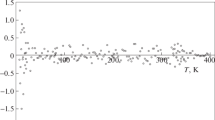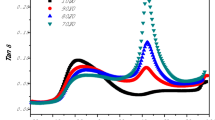Abstract
Poly(ethyl-n-butylsilylene) (PEBS) was synthesized by sodium coupling of ethyl-n-butyldichorosilane and separated into fractions with differing molecular weights,M w=1.4×106 and 2.0×104. Both fractions were studied by differential scanning calorimetry and by X-ray diffraction, UV spectroscopy, polarizing optical microscopy, and capillary rheometry, all as a function of temperature. Both samples adopt a hexagonal columnar liquid crystalline structure at room temperature and below. They undergo a weak endothermic transition at −20°C and a first-order phase transition to a nematic liquid crystalline form at 90°C for the low and 170°C for the highM w fraction. Melting to an isotropic liquid takes place at 106°C for the low and 185°C for the highM w polymer. Both samples undergo two successive thermochromic transitions in the UV, one near the first-order exothermic transition and one near the −20°C transition; the reasons underlying these thermochromic transitions are discussed. Flow properties of PEBS were investigated as a function of molecular weight.
Similar content being viewed by others
References
N. Matsumoto, K. Takada, H. Teramae, and M. Fujino, inSilicon-Based Polymer Science, J. M. Zeigler and F. W. G. Fearon, eds. (American Chemical Society, Washington, DC, 1990), pp. 517–541.
J. Michl,Synth. Metals 49, 367 (1992).
K. S. Schweitzer, L. A. Harrah, and J. M. Zeigler, inSilicon-Based Polymer Science, J. M. Zeigler and F. W. G. Fearon, eds. (American Chemical Society, Washington, DC, 1990), pp. 379–396.
For reviews see R. D. Miller and J. Michl,Chem. Rev. 89, 1359 (1989); R. West, inThe Chemistry of Organic Silicon Compounds, S. Patai and Z. Rappoport, eds. (John Wiley, New York, 1989), pp. 1207–1240.
E. K. Karikari, A. J. Gesco, B. L. Farmer, R. D. Miller, and J. F. Rabolt,Macromolecules 26, 3937 (1993).
H. Kuzmany, J. F. Rabolt, B. C. Farmer, and R. D. Miller,J. Chem. Phys. 85, 7413 (1986).
F. C. Schilling, F. A. Bovey, A. J. Lovinger, and J. M. Zeigler,Bull. Am. Phys. Soc. 33, 657 (1988).
T. Asuke and R. West,Macromolecules 24, 343 (1991); R. West, R. Menescal, T. Asuke, and J. Eveland,J. Inorg. Organomet. Polym. 4, 29–45 (1992).
BimodalM w distributions are commonly observed for polysilanes prepared by sodium coupling. For recent discussions see R. G. Jones, R. E. Benfield, R. W. Cragg, and A. C. Swain,J. Chem. Soc. Chem. Commun. 112 (1992); R. W. Cragg, R. G. Jones, A. C. Swain, and S. Webb,Macromolecules 26, 4878 (1993).
P. Weber, D. Guillon, A. Skoulios, and R. D. Miller,Liq. Crystals 8, 825 (1990).
Nematic-isotropic transformations in polymers with limited chain flexibility are well known. See Z. Y. Cheu,Macromolecules 26, 3419 (1993); A. Ciferri, W. R. Krigbaum, and R. B. Meyer (eds.),Polymer Liquid Crystals (Academic Press, New York, 1982).
G. M. Wallraff, M. Baier, R. D. Miller, J. F. Rabolt, V. Hallmark, P. Cotts, and P. Shukla,Polym. Prepr. 30, 245 (1989).
C. A. Walsh, F. C. Schilling, R. B. MacGregor, Jr., A. J. Lovinger, D. D. Davis, F. A. Bovey, and J. M. Ziegler,Synth. Met. 28, c559 (1989).
C. H. Yuan and R. West,Macromolecules 26, 2645 (1993).
K. Schweitzer,J. Chem. Phys. 85, 1176 (1986);Synth. Met. 28, 565 (1989).
F. Shafiee, K. J. Haller, and R. West,J. Am. Chem. Soc. 108, 5478 (1986).
R. D. Miller, B. L. Farmer, W. Fleming, R. Sooriyakumaran, and J. F. Rabolt,J. Am. Chem. Soc. 109, 2509 (1987).
O. Kratky and G. Porod,Recl. Trav. Chim. Pays-Bas 68, 1106 (1949).
P. S. Flory,Statistical Mechanics of Chain Molecules (Wiley-Interscience, New York, 1969), Chap. 1.
For theoretical support for this model, see S. H. Tersigni and W. J. Welsh,Comput. Polym. Sci. 2, 1 (1992).
E. B. Bagley,J. Appl. Phys. 28, 624 (1959).
M. L. Williams, R. F. Landel, and J. D. Ferry,J. Am. Chem. Soc. 77, 3701 (1955); E. N. Andrade,Nature 125, 309 (1930).
W. E. Rochefort, G. W. Heffner, D. S. Pearson, R. D. Miller, and P. M. Cotts,Macromolecules 24, 4861 (1991).
H. Munstedt,Kuntstoffe 68, 94 (1978).
Author information
Authors and Affiliations
Rights and permissions
About this article
Cite this article
Asuke, T., West, R. Poly(ethyl-n-butylsilylene): Structural, thermal, and flow properties of a liquid crystalline polysilane. J Inorg Organomet Polym 4, 45–59 (1994). https://doi.org/10.1007/BF00684027
Received:
Revised:
Issue Date:
DOI: https://doi.org/10.1007/BF00684027




